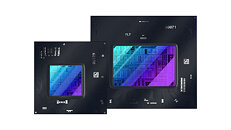
Intel Unveils Arc Pro Graphics Cards for Workstations and Professional Software
Intel has today unveiled another addition to its discrete Arc Alchemist graphics card lineup, with a slight preference to the professional consumer market. Intel has prepared three models for creators and entry pro-vis solutions, called Intel Arc Pro graphics cards. All GPUs are AV1 accelerated, have ray tracing support, and are designed to handle AI acceleration inside applications like Adobe Premiere Pro. At the start, we have a small A30M mobile GPU aimed at laptop designs. It has a 3.5 TeraFLOP FP32 capability inside a configurable 35-50 Watt TDP envelope, has eight ray tracing cores, and 4 GB of GDDR6 memory. Its display output connectors depend on OEM's laptop design.
Next, we have the Arc A40 Pro discrete single-slot GPU. Having 3.5 TeraFLOPs of FP32 single-precision performance, it has eight ray tracing cores and 6 GB of GDDR6 memory. The listed maximum TDP for this model is 50 Watts. It has four mini-DP ports for video output, and it can drive two monitors at 8K 60 Hz, one at 5K 240 Hz, two at 5K 120 Hz, or four at 4K 60 Hz refresh rate. Its bigger brother, the Arc A50 Pro, is a dual-slot design with 4.8 TeraFLOPs of single-precision FP32 computing, has eight ray tracing cores, and 6 GB of GDDR6 memory as well. It has the same video output capability as the Arc A40 Pro, with a beefier cooling setup to handle the 75 Watt TDP. All software developed using the OneAPI toolkit can be accelerated using these GPUs. Intel is working with the industry to adapt professional software for Arc Pro graphics.
Next, we have the Arc A40 Pro discrete single-slot GPU. Having 3.5 TeraFLOPs of FP32 single-precision performance, it has eight ray tracing cores and 6 GB of GDDR6 memory. The listed maximum TDP for this model is 50 Watts. It has four mini-DP ports for video output, and it can drive two monitors at 8K 60 Hz, one at 5K 240 Hz, two at 5K 120 Hz, or four at 4K 60 Hz refresh rate. Its bigger brother, the Arc A50 Pro, is a dual-slot design with 4.8 TeraFLOPs of single-precision FP32 computing, has eight ray tracing cores, and 6 GB of GDDR6 memory as well. It has the same video output capability as the Arc A40 Pro, with a beefier cooling setup to handle the 75 Watt TDP. All software developed using the OneAPI toolkit can be accelerated using these GPUs. Intel is working with the industry to adapt professional software for Arc Pro graphics.






































































